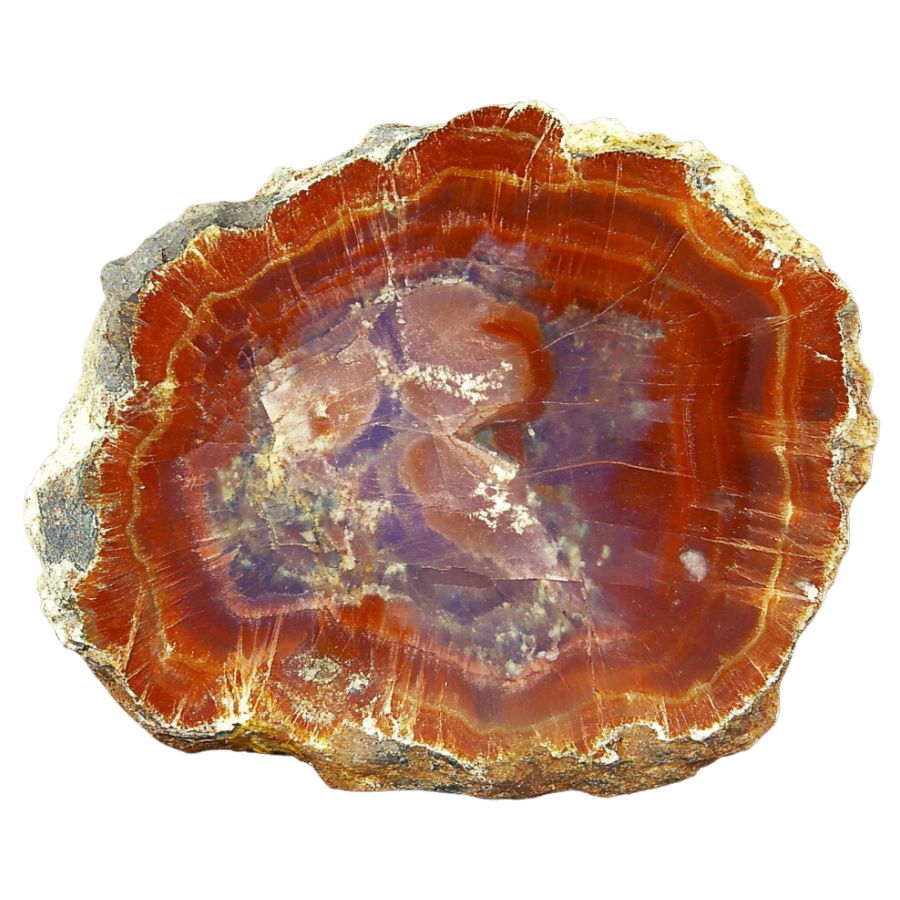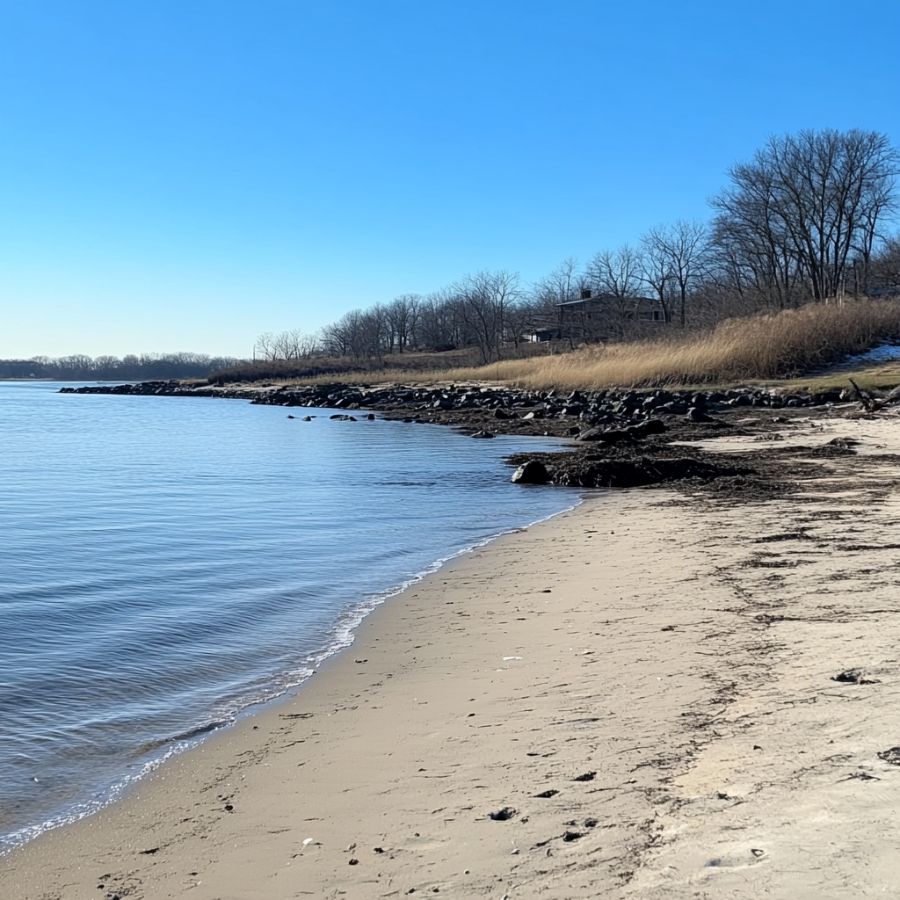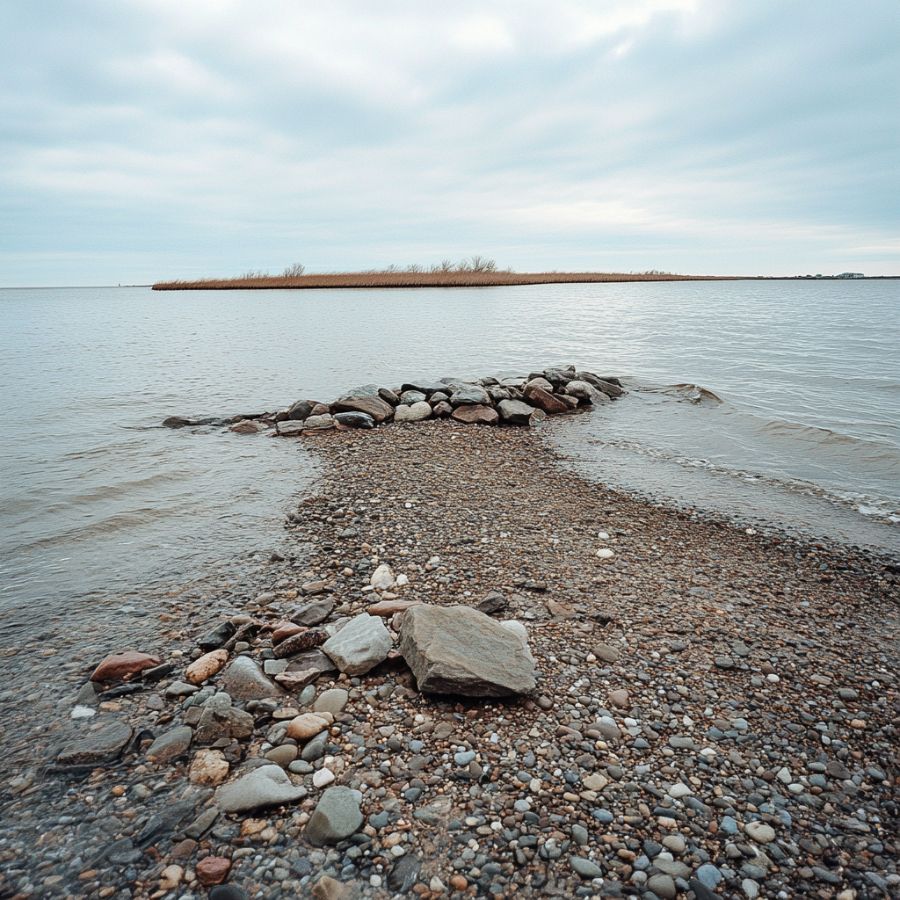From the Delaware River to the Atlantic Ocean, New Jersey offers hidden treasures for rock enthusiasts. This ancient, fossilized material captivates collectors and nature lovers alike.
We’ve done the legwork to bring you the top spots for finding petrified wood in New Jersey. Our carefully researched list will save you time and effort.
No more aimless searching or disappointing trips. Read on to discover the six best locations where you’re most likely to find petrified wood.
Petrified wood you can find in the US
In the United States, several types of petrified wood can be found, each with unique characteristics based on the original tree species and the minerals involved in the fossilization process. Here are some of the types you’ll be able to find.
Araucarioxylon

Found in the Petrified Forest National Park in Arizona, this is one of the most famous types of petrified wood. It comes from an extinct species of conifer. As Arizona’s state fossil, Araucarioxylon holds a special place in the state’s natural history.
These trees once formed vast forests during the Late Triassic period, about 225 million years ago. The vibrant colors in this petrified wood come from minerals that replaced the original tree material over time.
Metasequoia

Often referred to as dawn redwood, this type of petrified wood can be found in various parts of the U.S., including the Pacific Northwest. Metasequoia was once thought to be extinct until living trees were later discovered in China.
Furthermore, its fine grain and reddish-brown color are characteristic features.
Palmoxylon

This petrified wood originates from palm trees and is often found in the Gulf Coast states like Texas and Louisiana. Recognized as the state stone of Texas, Palmoxylon is abundant and holds cultural significance.
The wood’s unique speckled or dotted pattern comes from the vascular bundles of the original palm tree. These fossils date back to the Cretaceous period, when the area was tropical and teeming with life.
Taxodium

Also known as bald cypress, this petrified wood can be found in the southeastern U.S., particularly in areas that were once swampy. Taxodium wood is often found in places that were ancient swamps, where these trees thrived millions of years ago.
The wood is durable and shows intricate grain patterns, with growth rings and knotholes that tell the story of its long history. It’s a fascinating glimpse into the wet environments that once dominated the Southeast.
Sequoioxylon

Petrified wood from ancient sequoia trees, found in places like California, where sequoia forests once thrived. These trees are the ancestors of the giant sequoias that still stand in California today.
The petrified wood is notable for its large, straight grain and reddish color, reflecting the immense size and age of the original trees.
Ginkgoxylon

Petrified wood from ancient ginkgo trees, which can sometimes be found in states like Oregon and Washington. Ginkgo is one of the oldest tree species on Earth, with fossils dating back over 200 million years.
Ginkgo petrified wood often has a light color and may show patterns similar to the fan-shaped leaves of the living ginkgo.
Dicotyledonous Wood

Found across various states, this type of petrified wood comes from broadleaf trees, making it more common and varied in appearance. You can spot dicotyledonous wood by the distinct vessels and growth rings that indicate seasonal changes.
This type of petrified wood is often found in regions that were once temperate forests, offering clues about the diverse plant life that existed millions of years ago.
Piceoxylon

Petrified wood from ancient spruce trees, commonly found in areas like Wyoming and Montana, where coniferous forests once thrived. Piceoxylon is known for its straight grain and pale color, often showing growth rings that tell the tree’s life story.
These trees were part of the ancient boreal forests that covered large parts of North America during cooler periods.
A Quick Request About Collecting
Always Confirm Access and Collection Rules!
Before heading out to any of the locations on our list you need to confirm access requirements and collection rules for both public and private locations directly with the location. We haven’t personally verified every location and the access requirements and collection rules often change without notice.
Many of the locations we mention will not allow collecting but are still great places for those who love to find beautiful rocks and minerals in the wild without keeping them. We also can’t guarantee you will find anything in these locations since they are constantly changing.
Always get updated information directly from the source ahead of time to ensure responsible rockhounding. If you want even more current options it’s always a good idea to contact local rock and mineral clubs and groups
What Rough Petrified Wood Looks Like
Most of the photos you find of petrified wood are pieces that have been cut and polished. That is certainly useful but isn’t super helpful once you are out in the field. This is what you should look out for once you start hunting:
Exteriors like this

Every type of petrified wood has a different exterior and pattern but this is a good starting point on what to look for.
Texture and grain patterns

One of the most distinctive features to look for is the texture and grain patterns. Petrified wood often retains the original structure of the tree, including the grain, knots, and even growth rings. These patterns can appear similar to modern wood but are typically more rigid and fossilized.
Examine the surface for any linear patterns or striations that indicate the original wood grain. The texture may feel smoother or more polished in certain areas where mineralization has created a glassy effect.
Coloration and mineralization

The color of petrified wood can vary significantly due to the minerals that replaced the organic material during the fossilization process. Common colors include shades of brown, red, yellow, orange, and black.
Some pieces might even exhibit multiple colors in intricate patterns. These colors are often more vivid and diverse than those found in regular rocks. When inspecting potential petrified wood, look for these distinct and varied hues, which can indicate the presence of different minerals such as silica, iron, manganese, and others that contributed to the petrification process.
Bark and exterior features

Another telltale sign of petrified wood is the presence of bark impressions or external textures that resemble tree bark. These features are often well-preserved and can include the rough, fibrous texture of bark, knots, or other surface irregularities typical of natural wood.
The exterior of rough petrified wood may also have a weathered appearance, with cracks and fractures that occurred as the wood fossilized over millions of years. Look closely for these natural wood features, as they can be a strong indicator that you have found a piece of petrified wood.
Weight and density

Petrified wood is typically much heavier and denser than regular wood due to the mineralization process. When rockhounding, pick up the specimen to feel its weight. Even small pieces of petrified wood will feel significantly heavier than an equivalent-sized piece of non-fossilized wood.
This increased density is due to the replacement of organic material with minerals, making petrified wood feel more like a rock than wood. Comparing the weight and density of your find with known samples of petrified wood can help confirm its authenticity.
- The extensive local experience of our team
- Input from a variety of local rockhounds and rockhound groups
- The difficulty in accessing a location
- Safety and potential hazards when collecting
- Private and public locations
- A desire to include locations for both the experienced and newbie hunters who are just starting out
Using these inputs we think we’ve put together the best list out there for those who love finding petrified wood for our collections!
General Areas To Try First

Before we get into the specific places you should be looking we wanted to give you some more general advice. Once you get to your hunting area you should head straight for these areas if you want to have the best results:
Lakeshores

Lakeshores are like natural garbage cans because all things wash up and get left there over time. That includes wood that has turned to stone. As the water rises and falls, it carries sediment and rocks. It also takes the fossilized remains of trees from long ago.
Most lakeshores have a variety of rocks and minerals, which makes them an excellent place for petrified wood to grow and thrive. You’ll find a nice mix of sedimentary and volcanic rocks, the best sites for preserving wood fossils.
Roadcuts

When building roads, parts of the ground are often cut away to make a smooth path. The magic happens when the road cuts through layers of rock and soil. Petrified wood is often buried deep underground, and roadcuts let us see these underground wonders.
As workers blast through the rock layers, they accidentally find petrified wood that has been there for hundreds of years. Petrified wood is easy for collectors to spot because the exposed rock layers of roadcuts make it easy to see its unique patterns and colors.
Streams and creeks

Streams and creeks can move loose sediment away, which can reveal old wood that has turned to stone. As the water moves around, it exposes small pieces or even more significant amounts of petrified wood that have settled on the streambed.
Streams and creeks are more accessible for collectors because they are not as big. You can easily walk along their banks, jump from rock to rock, and look for petrified wood at the water’s edge.
River beds

Riverbeds are excellent for finding petrified wood due to their unique geological and environmental conditions. Rapid burial by sediments like sand, silt, and mud protects fallen trees from decay, initiating the fossilization process.
Mineral-rich waters flowing through rivers facilitate the replacement of organic material with minerals such as silica, turning wood into stone. Over time, erosion exposes these buried treasures, making them accessible for discovery.
This dynamic environment, with constant sediment deposition and mineral infiltration, creates ideal conditions for the formation and eventual exposure of petrified wood.
The Best Locations For Finding Petrified Wood in STATE
Exploring the top places in New Jersey can significantly boost your chances of finding petrified wood. By focusing your search on these well-regarded locations, you’ll be well on your way to uncovering petrified wood.
DON'T MISS OUT ON ANY GREAT FINDS!
While you're out searching for Petrified Wood you're going to find A LOT of other interesting rocks and minerals along the way. The last thing you want to do is toss out something really interesting or valuable. It can be easy to misidentify things without a little guidance.
We've put together a fantastic field guide that makes identifying 140 of the most interesting and valuable rocks and minerals you will find REALLY EASY. It's simple to use, really durable, and will allow you to identify just about any rock and mineral you come across. Make sure you bring it along on your hunt!
Sayreville

Sayreville, located in the southeastern part of New Jersey along the Raritan River, is a hidden gem for rockhounding enthusiasts. This borough is rich in geological history, primarily due to its clay mining past.
The area’s clay pits and quarries have yielded fascinating finds, including the oldest amber in the Americas, dating back 90-92 million years.
The unique landscape of Sayreville features exposed sedimentary layers, making it an intriguing spot for discovering various minerals.
Rockhounds can explore the old clay pits and the banks of the Raritan River, where sedimentary deposits may conceal pieces of amber and pyrite. These locations are ideal for digging around gravel beds and creek banks, where the ancient riverbeds have left behind remnants of prehistoric plant life.
Manasquan Beach

Located in the southern part of New Jersey, Manasquan Beach in Monmouth County is a prime spot for gemstone enthusiasts.
This beautiful coastal area is known for its unique geological features, including sandy shores and gravel deposits that have been shaped by the Atlantic Ocean.
Petrified wood can often be found among the beach gravels, remnants of ancient trees that have turned to stone over millions of years. The beach is not only a great place for finding petrified wood but also for discovering ‘Cape May Diamonds’, which are weathered quartz crystals.
The shifting sands and tides expose new areas for exploration, making each visit potentially rewarding. Fossils and other geological treasures can also be uncovered, adding to the excitement of rockhounding here.
Carnelian Brook

Carnelian Brook is located within Warren Township in the northern part of New Jersey. This serene stream, also known as Stirling Brook, flows through the picturesque Watchung Mountains, which are renowned for their volcanic origins.
The unique geological features of this area contribute to the rich variety of minerals found here, including carnelian agate and the sought-after petrified wood.
Collectors can explore the gravels and sands along the brook’s banks and shallow areas, where interesting finds await. The streambed is particularly promising after heavy rains, as erosion can reveal new treasures.
The Watchung Mountains provide a stunning backdrop, making your rockhounding adventure not only fruitful but also visually rewarding.
Cape May Peninsula

Cape May Peninsula is located in the southernmost part of New Jersey, bordered by the Atlantic Ocean to the east and Delaware Bay to the west.
This low-lying area is known for its rich geological history and unique coastal environments, making it an excellent spot for rockhounding enthusiasts.
Petrified wood can often be found among the beach gravels, alongside the famous “Cape May Diamonds,” which are actually weathered quartz crystals.
The peninsula’s geological features, shaped by ancient marine transgressions, contribute to the diverse sedimentary deposits that make this location special.
For those hunting for petrified wood, Higbee Beach and other nearby coastal areas provide the best opportunities. Here, you can sift through the sands and gravels, particularly in the creeks and streams that run through the area.
Gibbsboro borough

Gibbsboro, located in the southern part of New Jersey, is a charming borough in Camden County. This area is known for its rich geological history, particularly the Raritan Formation, which dates back to the Cretaceous period.
Rockhounds can explore various locations within Gibbsboro to search for petrified wood. Creeks and streams in the area often expose sedimentary layers where fossils and stones can be found.
Gravel beds along these waterways are particularly promising, as they may contain eroded pieces of petrified wood. Additionally, construction sites may reveal new geological layers, offering opportunities for discovery.
The unique combination of sedimentary rock formations and the area’s historical significance makes Gibbsboro an intriguing destination for gemstone enthusiasts.
Our Other Favorite Places For Petrified Wood
Following our discussion of the top picks, we would like to highlight the other locations on our list. Below, you will find a comprehensive overview of these additional sites, organized by county.
| County | Location |
| Camden | Haddonfield area |
Always Confirm Access and Collection Rules!
Before heading out to any of the locations on our list you need to confirm access requirements and collection rules for both public and private locations directly with the location. We haven’t personally verified every location and the access requirements and collection rules often change without notice.
Many of the locations we mention will not allow collecting but are still great places for those who love to find beautiful rocks and minerals in the wild without keeping them. We also can’t guarantee you will find anything in these locations since they are constantly changing.
Always get updated information directly from the source ahead of time to ensure responsible rockhounding. If you want even more current options it’s always a good idea to contact local rock and mineral clubs and groups


